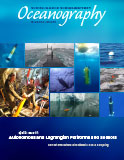Article Abstract
The Argo Program has revolutionized large-scale physical oceanography through its contributions to basic research, national and international climate assessment, education, and ocean state estimation and forecasting. This article discusses the present status of Argo and enhancements that are underway. Extensions of the array into seasonally ice-covered regions and marginal seas as well as increased numbers of floats along the equator and around western boundary current extensions have been proposed. In addition, conventional Argo floats, with their 2,000 m sampling limit, currently observe only the upper half of the open ocean volume. Recent advances in profiling float technology and in the accuracy and stability of float-mounted conductivity-temperature-depth sensors make it practical to obtain measurements to 6,000 m. The Deep Argo array will help observe and constrain the global budgets of heat content, freshwater, and steric sea level, as well as the full-depth ocean circulation. Finally, another extension to the Argo Program is the addition of a diverse set of chemical sensors to profiling floats in order to build a Biogeochemical-Argo array to understand the carbon cycle, the biological pump, and ocean acidification.

